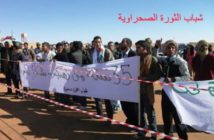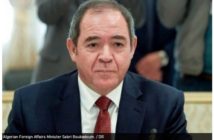Maroc.ma
 Moroccan Minister of Communications Mustafa al-Khalfi, the official government spokesman, revealed the existence of a historical document that confirms a link between the inhabitants of Western Sahara and the central authorities in Morocco that dates back to before the Spanish occupation. He believes that a return to international agreements goes against the idea that the region was “empty land.”
Moroccan Minister of Communications Mustafa al-Khalfi, the official government spokesman, revealed the existence of a historical document that confirms a link between the inhabitants of Western Sahara and the central authorities in Morocco that dates back to before the Spanish occupation. He believes that a return to international agreements goes against the idea that the region was “empty land.”
In an interview with Al-Hayat, he explained the reasons behind the failure of a referendum, and revealed the content of the autonomy plan proposed by his country.
Below is the full text of the interview:
Al-Hayat: The problem relating to Western Sahara region has drawn out for a long time, and witnessed complications through its many stages. What is the basis of Morocco’s statements regarding its historical rights in this region?
Khalfi: We are not here to claim historical rights, this is Morocco’s right and it doesn’t need to claim anything. But unfortunately there is ignorance regarding the history of the Moroccan Sahara, whose tribal structure merged with the ancient tribes of Sanhaja in forming the ethnic, cultural and social fabric of Morocco as a whole. This is evidenced by various texts written by regional historians, such as Ibn Khaldoun, Abu al-Qasim al-Zayyani, Ibn al-Adra and al-Nasari. These texts are full of evidence showing the deep-rooted links between Western Sahara and Morocco. The Sahara region formed the natural geographic extension of northern Morocco. Moreover, there is a strong overlap in tribal structure, a shared linguistic framework and the inhabitants of both regions follow a unified school of Islamic jurisprudence, the Maliki school.
Al-Hayat: Are there documents and texts supporting this proposal?
Khalfi: The Moroccanness of Western Sahara is something well-established historically, socially and legally. There are hundred of pieces of evidence in this regard, including documents about the legitimate allegiance of the Saharan tribes to the state, as well as the International Court of Justice’s advisory opinion issued in 1975.
This evidence also includes correspondence, appointments of judges and leaders, and commissions directed towards the Sahara tribes, which maintained allegiance to the central authorities and Morocco’s sovereignty. There are also more than 12 international treaties — with Britain, the United States, France and Spain — which almost all concur that the Sahara region is not exempt from applying agreements between Morocco and these countries.
A telling example of this is the fact that Sheikh Ma al-Aynayn, a Saharan leader and senior scholar, was appointed as a deputy of Sultan Hassan I in the Sahara regions at the end of the 1870s, that is,. roughly ten years before the Spanish occupation of Western Sahara. With the onset of the colonial incursion in Morocco, Aynayn led a large military campaign that included many Saharan tribes to resist the French campaign in Morocco. After his death in 1910, his son, Ahmed al-Heiba Ma al-Aynayn, continued this campaign and confronted the French colonial forces in a fierce battle, known as the Battle of Sidi Bousman, north of Marrakech in 1912.
Unfortunately, and despite the clarity of this framework, the conflict has taken on regional and international strategic dimensions, which has made it an extension of the Cold War and regional conflicts. This has reflected on the stability of the region, along with the stability of the Sahel and the Sahara desert regions. It has also had an impact on the aspirations of the region’s people regarding integration and unity, and deepened the tragedy of Moroccan Sahara residents in the Tindouf camps.
Al-Hayat: In your view, what are the reasons for the failure of the referendum plan, and what are Morocco’s initiatives to reach a settlement?
Khalfi: The referendum plan has failed and reached a deadlock for a number of reasons, which are documented in the reports issued by the secretary-general of the United Nations in 2001 and 2003. The most important of these relates to the tribal structure of the Sahara’s inhabitants and their nomadic nature, as well the limited scope of the list of voters who were eligible to participate in the referendum. More than 131,000 appeals were lodged against the first list alone [by inhabitants on the Moroccan side who were deem ineligible to participate], which limited participation to approximately 84,000 people in 1999.
At the time, the secretary-general of the U.N. said that the process of dealing with appeals would be long and arduous, and that it would bring about new disputes regarding the identification process. This meant we would enter into a new tunnel without an end in sight. This pushed the former secretary general and his Personal Envoy James Baker to say in 2000 that there was no point in continuing the talks, unless Morocco — as the administration authority, according to the UN — transferred a part of the government’s authority to all of the region’s resident, both past and present. They called for a real and substantial transfer of power, in line with administrative international standards. This is according to a well-known report by Kofi Annan presented to the Security Council in June 2001.
Morocco has at many times expressed its desire to reach a solution that preserves Moroccan sovereignty, as well as territorial and national unity. At the same time, Morocco seeks a solution that would respect the unique culture of this region, and allow its inhabitants to manage their own developmental, economic, political, social and cultural affairs, within the national fabric. This elicited positive reactions to Baker’s first plan for a settlement, however, the developments that followed — particular from 2002-2005 — derailed the plan and renewed fears of the rejected division, and thus of a return to the first settlement plan.
Morocco then submitted its expanded autonomy plan proposal in April 2007, which granted the southern regions of the kingdom autonomy, similar to other previous international solutions to solve various conflicts. This would lead to granting the Sahara residents wider powers in managing their own affairs, within the framework of Moroccan sovereignty.
Here I would like to mention the notable reaction of the Security Council to the Moroccan initiative. U.N. Security Council Resolution 1754 of 2007 welcomed Morocco’s serious and credible efforts to move the process forward towards resolution. Moreover, a number of international powers — including France and the U.S. — described the autonomy proposal as serious and credible. This was confirmed in a series of UN resolutions. Resolution 1813 of 2008 endorsed the previous UN report’s recommendation that realism and a spirit of compromise are essential to maintain the momentum of the process of negotiations.
Here we should note the findings of the previous envoy of the secretary-general of the U.N., Peter van Walsum. After a round of direct negotiations between 2007 and 2008, van Walsum said that separation was not a realistic option.
Al-Hayat: Several criticisms have been made regarding the human rights situation in the region, what is your assessment of these claims?
Khalfi: It is interesting that the assessments of the human rights situation in the kingdom’s southern regions are an attempt to cover up human rights violations in the Tindouf camps. Before discussing the latter, I would like to emphasize that a number of years ago Morocco chose to responsibly confront the issue of human rights abuses in the Sahara region. The government is striving to take the necessary measures to limit these violations and expand liberties.
The first step in this regard involved the creation of the Independent Arbitration Commission, followed by the creation of the Equity and Reconciliation Commission. These commissions were formed to address all problems related to the grave human rights violations, to turn the page on the past, and to seek the truth regarding the violations that took place between 1956 and 1999. They have received nearly 5,000 applications for compensation from Western Sahara residents, and have allocated $72 million in compensation to many of these people.
This is in addition to social integration efforts, with the majority of beneficiaries on the national level coming from the southern Sahara regions. Furthermore, in 2011 the National Council for Human Rights set up three regional committees in Western Sahara, which included Moroccan Sahrawi activists. I have previously praised the UN Security Council regarding Resolution 1979 of 2011, which created a National Council for Human Rights in Morocco. More than 22 delegations visited the area since 2011, with the most recent being a press delegation from the International Women’s Media Foundation.
As for the human rights situation in the camps, it is sufficient to look at the section on the Tindouf camps in the report issued by Human Rights Watch in 2008, entitle “Human Rights in Western Sahara and in the Tindouf Refugee Camps.” This report talks about slavery in the camps, as well as a lack of freedom of expression for opponents of the Polisario Front. They are also denied the right to return to these camps. HRW has presented documents proving this, with the knowledge that precise and comprehensive investigation is difficult, given the domination and control [of the Polisario] in these camps.
Take, for example, the case of Mustapha Salma Ould Sidi Mouloud, a former Polisario police chief in the Tindouf camps. Sidi Mouloud was banned from returning to the camps because he criticized Polisario leaders and voiced his support for the autonomy plan. He is still seeking refuge in Mauritania. There is also Najm Allal, a Sahrawi musician who has been subject to ongoing repression.
We only need to look at the reports issued by the UN High Commissioner for Refugees, which speak of the urgent needs of the camps’ residents due to the squalid conditions, especially given the decrease in the amount of aid provided to the Polisario and the emergence of the problem related to a census in the camps.
Since 2005, the UN has reduced the [number of those classified as “vulnerable refugees”] from 158,000 to 90,000. In their most recent resolution, the Security Council called for this census to be carried out, in light of objections on the part of Algeria and the Polisario. This objection is very telling, for they fear that the reality will be exposed. Likewise, since 2005 the U.S. has issued a number of reports prepared by credible organizations that confirm the Polisario is reselling a part of the international food aid for refugees on the black market. These reports were issued before Congress.
Al-Hayat: How are you managing the issue of natural wealth in the region?
Khalfi: First I’d like to point out that natural wealth is managed in accordance with development requirements and the needs of the residents. It is not managed based on the logic that it is sufficient to merely invest natural resources, which fails to meet pressing needs. Thus, Morocco has doubled its investments in various fields [in Western Sahara], and revenues from these investments surpass those of phosphate many times over. In addition, Morocco has achieved a number of accomplishments on the level of human development through elected institutions. The latter consists of 87 local councils and three provincial councils, as well as 52 deputies and consultants in parliament — all of which represent a mechanism for studying and tracking projects. Moreover, Morocco is currently preparing to set out a decentralized regional program for economic and social development. The Economic and Social Council recently presented the directive for this program to His Majesty the King.
I’d also like to note that only about 10% of Moroccan national phosphate production comes from Western Sahara, according to figures from 2010 and 2011. This amounts to about 2.8 million tons of phosphate. Moreover, this phosphate represents less than 8% of the transactions made by the national Moroccan phosphates company, Office Cherifien des Phosphates, in 2011. The net output for that year was less than 2 billion Moroccan dirhams [$239 million]. In 2010, the profits did not exceed 130 million Moroccan dirhams [$15.5 million]. Investments planned for the period between now and 2020 are estimated at 20 billion Moroccan dirhams [$2.4 billion], an amount that exceeds the annual earning rate of the Fos Boukraa mine. Yet huge investments are being made in this sector to enable the Fos Boukraa mine to continue operations. The most recent investment in this regard amounted to $325 million.
More than 20 billion Moroccan dirhams [$2.4 billion] were pumped in infrastructure projects — such as roads, seaports and airports — since 1975 until the beginning of the past decade, out of a total of 90 billion Moroccan dirhams [$10.7 billion] invested in the region as a whole. Between 2004 and 2008, over 7.9 billion Moroccan dirhams [$943 million] were invested in a 226 projects.
These investments have enabled the region to double its Human Development Index (HDI), and the region’s HDI is now among the best in the nation. This has garnered international praise. Likewise, the poverty rate decreased by a factor of five between 1975 and 2009, making it one of the least poor regions in Morocco. Such efforts have been made and are continuously being made, because the Sahara region — including both the inhabitants and the land — is an integral part of Morocco, despite ongoing disputes.






